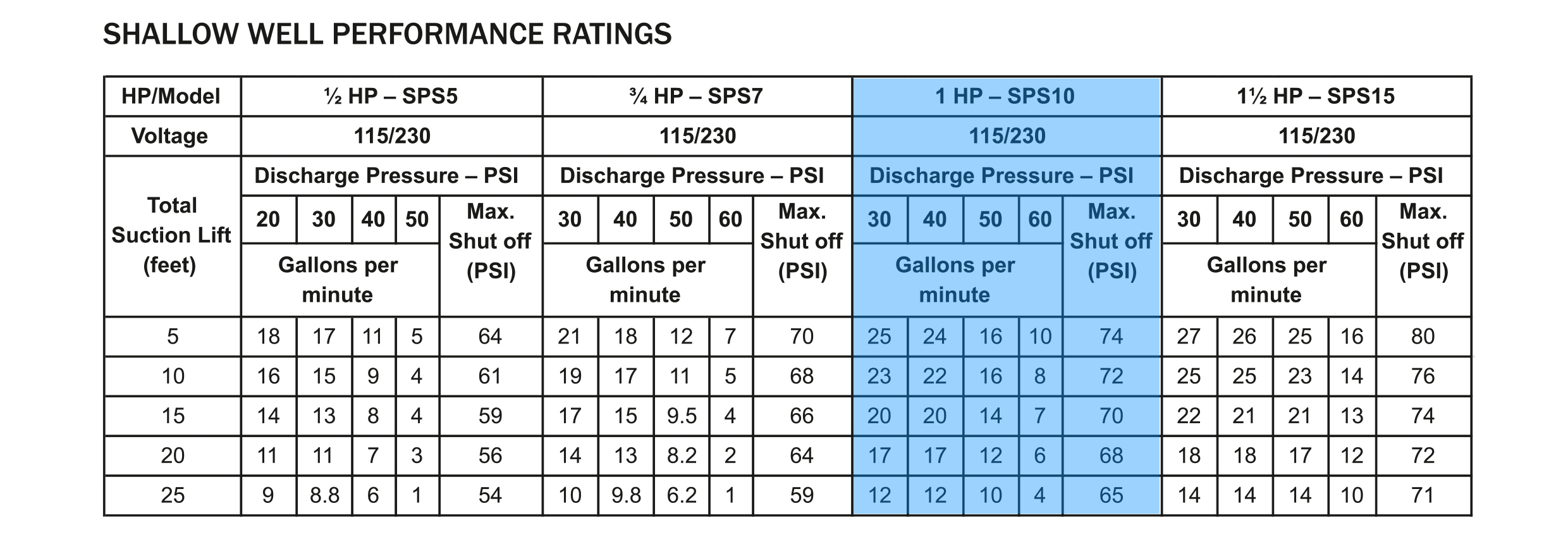Shakti SPS10 1HP Shallow Nose Jet Pump

Introducing the Shakti SPS10 1HP Shallow Nose Jet Pump, a reliable and efficient solution for your water pumping needs. Designed with a robust cast iron construction, this pump ensures durability and longevity, making it an excellent addition to your home or agricultural setup.
- Motor Horsepower: 1 HP
- Nose Type: Single
- Voltage: 115/230 V
- Amperage: 16.2/8.1 A
- Material: Cast Iron
- Model Number: SPS10
Categories:
This product belongs to the following categories:
- Jet Pumps from Shakti
- Jet Pumps from Goulds and Shakti
- Pumps, Tanks & Well Components
- Products
- Root Catalog
Whether you need to supply water to your home, garden, or livestock, the Shakti SPS10 is engineered to deliver exceptional performance and reliability. With its easy installation and maintenance, this shallow nose jet pump is the ideal choice for both residential and commercial applications.
Self Priming Centrifugal Pump
The self priming pump, once initially primed, is engineered to automatically re-prime itself when operating nder lift conditions. With rapid self-priming capability and consistent performance, this pump offers a variety of features that enhance its usability and convenience.
Self-priming centrifugal pumps are versatile and efficient machines that can handle a wide range of pumping applications. Unlike traditional pumps, they have the unique ability to prime themselves, eliminating the need for manual priming and ensuring a quick and hassle-free operation.
From enhanced productivity and cost savings to reduced downtime and improved safety, these pumps offer a host of benefits that can positively impact your operations.
Shakti Self Priming Centrifugal Pump
Advantages of self-priming centrifugal pumps
Shakti Self-priming centrifugal pumps offer a range of advantages that make them an ideal choice for many pumping applications. One of the primary benefits is their ability to eliminate the need for manual priming. With traditional pumps, operators often had to spend valuable time manually priming the pump before it could start pumping. Self-priming pumps, on the other hand, can automatically prime themselves, saving time and effort.
Additionally, Self Priming Centrifugal Pumps are highly efficient. Their design allows for a continuous flow of liquid, minimising any interruptions in the pumping process. This results in enhanced productivity and reduced downtime, making these pumps an excellent choice for applications that require a reliable and efficient pumping solution.
Another advantage of Self Priming Centrifugal Pumps is their versatility. These pumps can handle a wide range of fluids, including liquids with high viscosity or containing solids. Their ability to handle such diverse fluids makes them suitable for various industries, including wastewater treatment, chemical processing, agriculture, and construction.
Applications of Self Priming Centrifugal Pumps
Self Priming Centrifugal Pumps find applications in a wide range of industries and pumping scenarios. One common application is in the wastewater treatment industry. These pumps are used to transfer wastewater from one location to another, making them an essential component of sewage treatment plants, industrial waste disposal systems, and drainage systems.
The construction industry also relies heavily on self-priming centrifugal pumps. They are commonly used for dewatering excavations, removing water from construction sites, and pumping water for construction processes. Their ability to handle solids and high-viscosity fluids makes them well-suited for these demanding applications.
In the agricultural sector, self-priming centrifugal pumps are used for irrigation, transferring water from wells or reservoirs to fields. Their self-priming capabilities and ability to handle debris make them an efficient choice for agricultural applications.
Maintenance and troubleshooting tips for self-priming centrifugal pumps
Proper maintenance is essential to ensure the longevity and optimal performance of self-priming centrifugal pumps. Regular inspection of the pump's components, such as the impeller, casing, and seals, is necessary to identify any signs of wear or damage. Any worn or damaged parts should be replaced promptly to prevent further issues.
It is also crucial to maintain the priming chamber and check valves. The priming chamber should be kept clean and free from debris to ensure proper self-priming operation. The check valves should be inspected regularly and cleaned or replaced if necessary to prevent any flow restrictions.
When troubleshooting self-priming centrifugal pumps, it is essential to check for common issues such as air leaks, clogged suction lines, or faulty check valves. These issues can disrupt the self-priming process and affect the pump's performance. Regularly monitoring the pump's operation and addressing any issues promptly can help prevent costly downtime.
| Phase | 1 |
|---|---|
| Motor Horsepower | 1 |
| Nose | Single |
| Material | Cast Iron |
| Source | https://www.shaktipumps.com/ |
| Model # | SPS10 |
| Shipping Weight | 47 |


 Shakti SPS10 1HP Shallow Nose Jet Pump
Shakti SPS10 1HP Shallow Nose Jet Pump




Validate your login